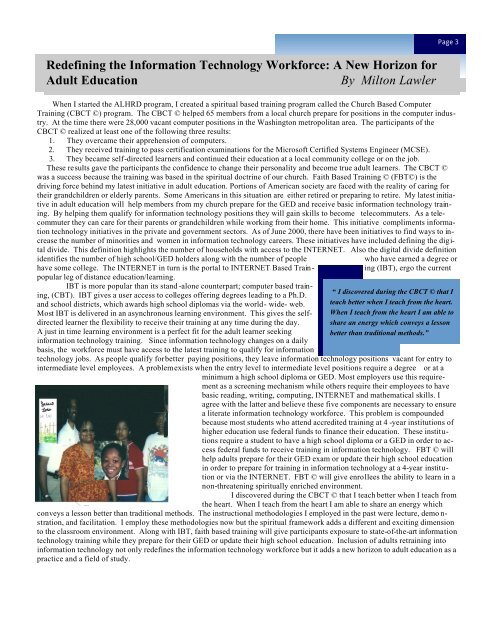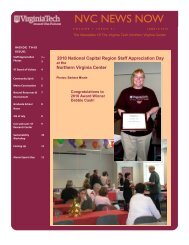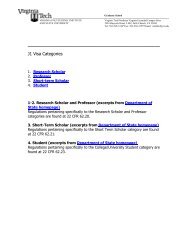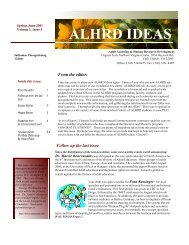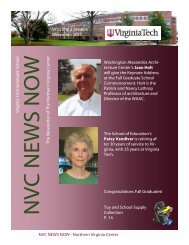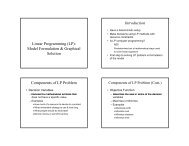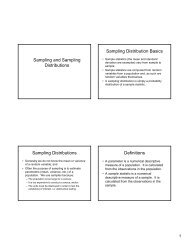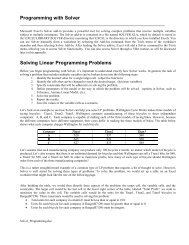ALHRD/ IDEAS - Northern Virginia Center - Virginia Tech
ALHRD/ IDEAS - Northern Virginia Center - Virginia Tech
ALHRD/ IDEAS - Northern Virginia Center - Virginia Tech
You also want an ePaper? Increase the reach of your titles
YUMPU automatically turns print PDFs into web optimized ePapers that Google loves.
Page 3<br />
Redefining the Information <strong>Tech</strong>nology Workforce: A New Horizon for<br />
Adult Education<br />
By Milton Lawler<br />
When I started the <strong>ALHRD</strong> program, I created a spiritual based training program called the Church Based Computer<br />
Training (CBCT ©) program. The CBCT © helped 65 members from a local church prepare for positions in the computer industry.<br />
At the time there were 28,000 vacant computer positions in the Washington metropolitan area. The participants of the<br />
CBCT © realized at least one of the following three results:<br />
1. They overcame their apprehension of computers.<br />
2. They received training to pass certification examinations for the Microsoft Certified Systems Engineer (MCSE).<br />
3. They became self-directed learners and continued their education at a local community college or on the job.<br />
These results gave the participants the confidence to change their personality and become true adult learners. The CBCT ©<br />
was a success because the training was based in the spiritual doctrine of our church. Faith Based Training © (FBT©) is the<br />
driving force behind my latest initiative in adult education. Portions of American society are faced with the reality of caring for<br />
their grandchildren or elderly parents. Some Americans in this situation are either retired or preparing to retire. My latest initiative<br />
in adult education will help members from my church prepare for the GED and receive basic information technology training.<br />
By helping them qualify for information technology positions they will gain skills to become telecommuters. As a telecommuter<br />
they can care for their parents or grandchildren while working from their home. This initiative compliments information<br />
technology initiatives in the private and government sectors. As of June 2000, there have been initiatives to find ways to increase<br />
the number of minorities and women in information technology careers. These initiatives have included defining the digital<br />
divide. This definition highlights the number of households with access to the INTERNET. Also the digital divide definition<br />
identifies the number of high school/GED holders along with the number of people<br />
who have earned a degree or<br />
have some college. The INTERNET in turn is the portal to INTERNET Based Trainpopular<br />
leg of distance education/learning.<br />
IBT is more popular than its stand -alone counterpart; computer based training,<br />
(CBT). IBT gives a user access to colleges offering degrees leading to a Ph.D.<br />
and school districts, which awards high school diplomas via the world- wide- web.<br />
Most IBT is delivered in an asynchronous learning environment. This gives the selfdirected<br />
learner the flexibility to receive their training at any time during the day.<br />
A just in time learning environment is a perfect fit for the adult learner seeking<br />
information technology training. Since information technology changes on a daily<br />
basis, the workforce must have access to the latest training to qualify for information<br />
ing (IBT), ergo the current<br />
“ I discovered during the CBCT © that I<br />
teach better when I teach from the heart.<br />
When I teach from the heart I am able to<br />
share an energy which conveys a lesson<br />
better than traditional methods.”<br />
technology jobs. As people qualify for better paying positions, they leave information technology positions vacant for entry to<br />
intermediate level employees. A problem exists when the entry level to intermediate level positions require a degree or at a<br />
minimum a high school diploma or GED. Most employers use this requirement<br />
as a screening mechanism while others require their employees to have<br />
basic reading, writing, computing, INTERNET and mathematical skills. I<br />
agree with the latter and believe these five components are necessary to ensure<br />
a literate information technology workforce. This problem is compounded<br />
because most students who attend accredited training at 4 -year institutions of<br />
higher education use federal funds to finance their education. These institutions<br />
require a student to have a high school diploma or a GED in order to access<br />
federal funds to receive training in information technology. FBT © will<br />
help adults prepare for their GED exam or update their high school education<br />
in order to prepare for training in information technology at a 4-year institution<br />
or via the INTERNET. FBT © will give enrollees the ability to learn in a<br />
non-threatening spiritually enriched environment.<br />
I discovered during the CBCT © that I teach better when I teach from<br />
the heart. When I teach from the heart I am able to share an energy which<br />
conveys a lesson better than traditional methods. The instructional methodologies I employed in the past were lecture, demo n-<br />
stration, and facilitation. I employ these methodologies now but the spiritual framework adds a different and exciting dimension<br />
to the classroom environment. Along with IBT, faith based training will give participants exposure to state-of-the-art information<br />
technology training while they prepare for their GED or update their high school education. Inclusion of adults retraining into<br />
information technology not only redefines the information technology workforce but it adds a new horizon to adult education as a<br />
practice and a field of study.


